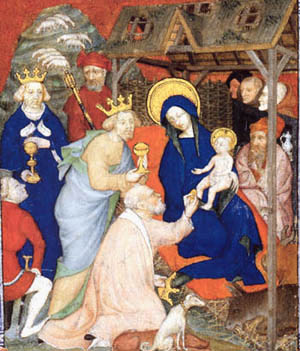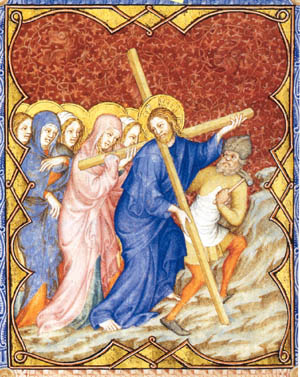 |
Feast of Our Lord
Epiphany of Our Lord – January 6
Prof. Plinio Corrêa de Oliveira
The feast of the Epiphany, the adoration of Our Lord in Bethlehem by the “Magi from the East” (Matthew 7), shows us the value of representation and symbolism in the plans of Divine Providence.

The Three Kings represented the Gentile peoples who would come to worship Christ |
It is generally said that the Three Magi came to adore Our Lord as representatives of the Gentile peoples. It is also common to say that they were magi because they represented the ancient wisdom of the East paying homage to Our Lord Jesus Christ. Magus, a word derived from the Greek, means a man of a great wisdom. The Three Magi came from different parts of the world to adore Our Lord as a sign that all nations were called to the light of the Faith.
Many progressivists and Protestants have expressed misgivings that they were kings. I do not see any reason for such doubt since Scripture foretold that Kings from different parts of the world would come to adore the Messiah (Psalm 2:10-12; 71:10-11; Is 60:11; 62:2).
At any rate, they were men from different races representing the old world and ancient wisdom who came to adore Our Lord and pay Him homage with gifts of gold, frankincense and myrrh. They traveled to Bethlehem moved by a very noble cause. According to their wise previsions and an interior call they received from God, they knew that the Messiah had been born.
This interior call shows us that God Himself chose them as representatives of the Gentile peoples. They fulfilled the vocation for which they were called, and on the Epiphany they paid homage to Our Lord. Each King who was present at the Manger kneeling before the Divine Infant represented his own personal fidelity, of course, but he also represented the fidelity of all the past kings as well as all the kings to come in History. They were only three, but they fulfilled that representation.

Our Lady and those who followed Christ in the Passion represent all the faithful through the ages |
We find something similar in the Passion and at the foot of the Cross. Our Lady, St. John, and the Holy Women represented everyone who had been, was, or would be faithful through the ages. For example, every faithful soul in History is represented by the act of Veronica wiping the Holy Face of Our Lord. The select group that was faithful on that solemn occasion represented the whole genre of faithful people.
We can ask if we can apply this rule to ourselves. Today the Catholic Church is humiliated by her own authorities, persecuted by Progressivism within her walls, immersed in the worst confusion that has ever fallen over her in History. We are just a few who want to remain faithful to the Church as she always was and to restore her to her past glory. In a certain way, we represent fidelity, purity, orthodoxy, courage, and the spirit of initiative and battle at the very moment when everything pressures everyone to give up, to step back, to flee.
Whom are we representing? In this new crucifixion of Our Lord, which is the crucifixion of the Church, we represent the faithful of the past who rest in the peace of the Lord and loved the Church. If St. Gregory VII, St. Louis of France, St. Ferdinand of Castile, St. Louis Grignon de Montfort, or Blessed Nuno Alvares could have seen in their times the crisis through which the Church is passing now and the few souls who would remain faithful, they would have blessed us from that distance. They would have considered themselves our cohorts and felt a relief that at least there were some small number doing what they would like to do.
We also are representing those unknown faithful souls spread throughout the world today who are smashed by Progressivism inside the Church and do not know what to do or where to go to be faithful. They would like to do what we are doing.
Finally, we are representing those who will come after us and who will be enthused when they look back and see what we are doing now. They will wish that they could have been with us now to assist us.

Clovis and his warriors represented a militant fidelity to Our Lord - Museum St. Remi, Reims |
In History some of these representations are quite impressive. For example, when St. Remigius was teaching King Clovis and his men the Catholic Faith to prepare them for Baptism and they heard about the Passion of Our Lord, Clovis cried out loudly and drove his lance in the ground saying: “Would that I were there with my Franks to prevent such an injustice!”
As he spoke, his Frankish warriors pounded their lances on the ground to signal their acquiescence. They did not realize it, but in a certain sense they were present at the Passion. For during it, Our Lord foresaw that action of Clovis and his Franks and it gave Him consolation.
There is, therefore, a kind of reversibility of action beyond time, where all the past and future fidelities converge in a single, grandiose scene that represents them all.
Today, Our Lady is like a prisoner who is insulted and ill-treated by men, and especially by the progressivist religious authorities. She came to warn mankind at La Salette and Fatima about this general apostasy in the Church. Her words were not heard. She also wept in various places - Syracuse, Rocca Corneta, New Orleans, Granada. Her tears beseech the few who remain faithful to save her from the horrible suffering of this passion of the Holy Church. It is an honor to be called to act at this extraordinary hour. If we correspond to this call, we will be wiping the holy face of Our Lady, as Veronica did for Our Lord, and we will be representing every faithful soul throughout History.
This doctrine of how a few persons can represent a whole genre, which we see in the adoration of the Three Magi, should encourage us. Let us ask them, who certainly are in Heaven with Our Lord, to give us the courage that we need:
* the courage to stand alone, as they did in the pagan world;
* the courage to wait for the appearance of a star, the signal that the hour of God has arrived for us to carry out His will;
* and the courage to do so promptly and with complete fidelity, as they did.


Watch a video illustration of this Saint of the Day article
here

  | |
Prof. Plinio Corrêa de Oliveira | |
The Saint of the Day features highlights from the lives of saints based on comments made by the late Prof. Plinio Corrêa de Oliveira. Following the example of St. John Bosco who used to make similar talks for the boys of his College, each evening it was Prof. Plinio’s custom to make a short commentary on the lives of the next day’s saint in a meeting for youth in order to encourage them in the practice of virtue and love for the Catholic Church. TIA thought that its readers could profit from these valuable commentaries.
The texts of both the biographical data and the comments come from personal notes taken by Atila S. Guimarães from 1964 to 1995. Given the fact that the source is a personal notebook, it is possible that at times the biographic notes transcribed here will not rigorously follow the original text read by Prof. Plinio. The commentaries have also been adapted and translated for TIA’s site.
|
Saint of the Day | Home | Books
| CDs | Search | Contact Us | Donate

© 2002- Tradition in Action, Inc. All Rights Reserved
|
 |
|